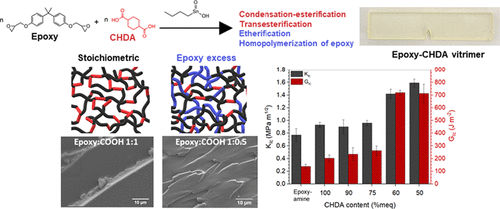当前位置:
X-MOL 学术
›
Macromolecules
›
论文详情
Our official English website, www.x-mol.net, welcomes your
feedback! (Note: you will need to create a separate account there.)
Epoxy Homopolymerization as a Tool to Tune the Thermo-Mechanical Properties and Fracture Toughness of Vitrimers
Macromolecules ( IF 5.1 ) Pub Date : 2021-09-15 , DOI: 10.1021/acs.macromol.1c00861 Kanokporn Tangthana-umrung 1 , Quentin Arthur Poutrel 2 , Matthieu Gresil 3
Macromolecules ( IF 5.1 ) Pub Date : 2021-09-15 , DOI: 10.1021/acs.macromol.1c00861 Kanokporn Tangthana-umrung 1 , Quentin Arthur Poutrel 2 , Matthieu Gresil 3
Affiliation

|
Epoxy/dicarboxylic acid vitrimer was prepared by the solvent-free reaction of diglycidyl ether of bisphenol A (DGEBA) and 1,4-cyclohexane dicarboxylic acid (CHDA) with the addition of monobutyltin oxide (Sn) as a catalyst. By tailoring the catalyst content (≥5 mol %), an effective conversion of functional groups during cure demonstrated the network polymerization mechanisms and a sequence of the side reactions. Indeed, the manufactured vitrimers exhibit creep and full stress relaxation thanks to catalytic transesterifications. By changing the epoxy/diacid ratio, the thermo-mechanical properties and mechanical behavior of the epoxy/acid vitrimers can be tuned while keeping self-healing ability. At high epoxy excess, both glass-transition temperature (Tg) and solid–liquid viscoelastic transition temperature (Tv) shift to a higher temperature. At vitrimer formulations 1:0.6 and 1:0.5 (epoxy/acyl), a remarkable improvement of fracture toughness (KIc) is observed, indicating the transition from stiff to relatively ductile materials at 1:0.6. This is attributed to the altered network structures due to etherification and epoxy homopolymerization. The rough fracture surface suggests more energy dissipation during crack propagation in vitrimer with a high excess epoxy. After healing, welded vitrimers still exhibit good fracture toughness with only a slight reduction (<10%) in KIc. We believe that these vitrimer formulations are promising as matrices in the composite fields.
中文翻译:

环氧树脂均聚作为调节玻璃体热机械性能和断裂韧性的工具
通过双酚 A 的二缩水甘油醚 (DGEBA) 与 1,4-环己烷二甲酸 (CHDA) 的无溶剂反应,加入单丁基氧化锡 (Sn) 作为催化剂,制备了环氧/二羧酸玻璃体。通过调整催化剂含量(≥5 mol%),固化过程中官能团的有效转化证明了网络聚合机制和一系列副反应。事实上,由于催化酯交换,制造的玻璃体表现出蠕变和完全应力松弛。通过改变环氧树脂/二酸的比例,可以在保持自愈能力的同时调整环氧树脂/酸玻璃体的热机械性能和机械性能。在环氧树脂过量时,玻璃化转变温度 ( T g) 和固液粘弹性转变温度 ( T v ) 转移到更高的温度。在玻璃体配方 1:0.6 和 1:0.5(环氧/酰基)下,观察到断裂韧性 ( K Ic )的显着提高,表明在 1:0.6 时材料从刚性转变为相对延展性。这归因于由于醚化和环氧树脂均聚而改变的网络结构。粗糙的断裂表面表明在具有高过量环氧树脂的玻璃体中裂纹扩展过程中更多的能量耗散。愈合后,焊接的玻璃体仍然表现出良好的断裂韧性,K Ic仅略微降低(<10%)。我们相信这些玻璃体配方作为复合材料领域的基质很有前途。
更新日期:2021-09-28
中文翻译:

环氧树脂均聚作为调节玻璃体热机械性能和断裂韧性的工具
通过双酚 A 的二缩水甘油醚 (DGEBA) 与 1,4-环己烷二甲酸 (CHDA) 的无溶剂反应,加入单丁基氧化锡 (Sn) 作为催化剂,制备了环氧/二羧酸玻璃体。通过调整催化剂含量(≥5 mol%),固化过程中官能团的有效转化证明了网络聚合机制和一系列副反应。事实上,由于催化酯交换,制造的玻璃体表现出蠕变和完全应力松弛。通过改变环氧树脂/二酸的比例,可以在保持自愈能力的同时调整环氧树脂/酸玻璃体的热机械性能和机械性能。在环氧树脂过量时,玻璃化转变温度 ( T g) 和固液粘弹性转变温度 ( T v ) 转移到更高的温度。在玻璃体配方 1:0.6 和 1:0.5(环氧/酰基)下,观察到断裂韧性 ( K Ic )的显着提高,表明在 1:0.6 时材料从刚性转变为相对延展性。这归因于由于醚化和环氧树脂均聚而改变的网络结构。粗糙的断裂表面表明在具有高过量环氧树脂的玻璃体中裂纹扩展过程中更多的能量耗散。愈合后,焊接的玻璃体仍然表现出良好的断裂韧性,K Ic仅略微降低(<10%)。我们相信这些玻璃体配方作为复合材料领域的基质很有前途。











































 京公网安备 11010802027423号
京公网安备 11010802027423号